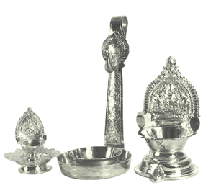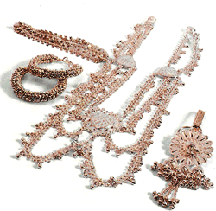|
|
Arts & Carfts - Maharashtra Tourism --- The Offical website of the
Maharashtra Tourism Development Corporation, Govt. of India
 |
| Silver Jewellery of
Hupri |
| The village of Hupri near Kolhapur has today become a busy and well known place
for silver jewellery. Silver jewellery of unique craftsmanship is executed here
with traditional artistry. |
| The speciality of siliver jewellery of Hupri is payal or anklet of various
types of length and design. Hupri is also famous for the seamless silver balls
known as gujrav. These hollow silver balls combined with solid ones, known as
rawa are added to payal as per design needs. There are a variety of designs
created through the stamped-out dies. Skilled craftsmen of Hupri turn out
complicated payals of different names such a painjan, koyali, kamarpattas etc.
They also make special kinds of necklaces. Silver jewellery from Hupri is in
great demand at home and abroad. Jewellery shops in Kolhapur, Miraj, Sangli,
Belgaum etc make good business of Hupri jewellery as women-folk in those areas
and elsewhere clamour for such silver ornaments. |
| The silver alloy used for jewellery is a compound of
silver, copper and zinc which is heated over a coke fire, over the choola
constructed indigenously. Clay-graphite crucibles, brought from Kerala, are
used for pouring the alloy into cast iron moulds of various traditional
designs. |
 |
|
| The process of making the seamless, hollow, silver balls is equally
interesting. It is a laborious task though. A tiny square piece of silver is
beaten into a hemisphere. Two such hemispheres are placed over each other but
cross-wise. By rolling the pieces in a groove on a special grindstone, all the
eight corners are folded over. These are then coated with the borax-ammonium
sulphate mixture and placed on an ash-covered tile, in rows. After heating them
with a hand-operated kerosene blow-torch, the pieces being to puff up like
purees. It is truly a fascinating sight to watch! |
|
 |
The story of Hupri silver jewellery goes
back to the first decade of this century, precisely the year 1904. in that year
Krishnaji Ramachandra Sonar switched over to making ornaments in silver from
gold. He would have hardly imagined that his silver craftsmanship would one |
|
| day
rise to such a height that within the nest four decades it would make Hupri
synonymous with silver smithing. |
The master craftsmen of Hupri moved with the times. Many changes took place in
their karkhanas) work - shops). Replacement of an imported, hand operated
'pasta' machine for making silver strips and a fly-press for stamping out dies
have changed the scene completely. Few years ago there were 9-10 karkhanas
(work-shops) employing 20- 30 craftsmen. During the span of fifteen years the
number of karkhanas reached to 60 and over 200 skilled craftsmen found |
|
| themselves overloaded with work. Out of the population of 18,000 in Hupri
village, about 4,000 men work as karigars and about 3,000 women work at chain
making in their spare time. Wages distributed to karigars every month go upto
Rs. 10-11 lakhs, totaling over a crore of rupees per annum. |
| Apart from this economic aspect one thing is certain, that there is a great
visual pleasure in looking at the silver ornaments of Hupri which are designed
and executed by extremely skilled and sensitive craftsmen of today who have
maintained the glorious tradition of the craftsmanship of our land. |
|
|
|
|
|
|